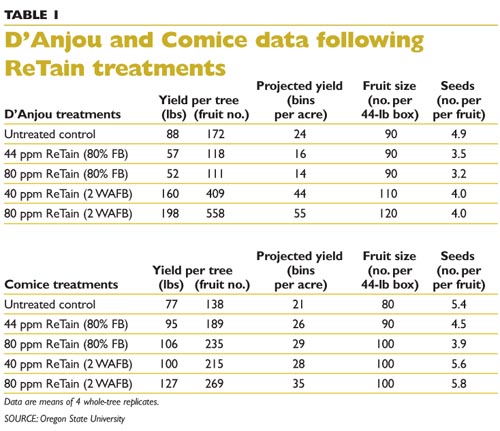Left: D’Anjou tree sprayed at two weeks after bloom with 80 ppm ReTain relative to an untreated control. Right: Untreated d’Anjou control tree. (Photos and figures courtesy Todd Einhorn)
Mature d’Anjou trees typically produce large fruit, despite the crop being unthinned. Bartletts require thinning to size fruit to commercial standards. Comice is a conspicuously shy bearer.
To improve production efficiencies of d’Anjou and Comice, bloom and postbloom applications of the plant growth regulator ReTain (aminoethoxyvinylglycine) were tested to promote fruit set. For Bartlett, we have recently explored a new chemical thinning agent.
ReTain
Ethylene is a naturally occurring plant hormone that promotes senescence in plant organs, such as flowers and fruit.
The active ingredient in ReTain inhibits ethylene synthesis and, therefore, could potentially be used to improve fruit set when limitations are due to a short ovule longevity period or high fruitlet abscission. In the case of a short ovule longevity period, ReTain applications made during bloom could potentially improve fruit set by extending the life of the ovule, thereby increasing the chance for fertilization.
However, when early fruitlet abscission reduces set, ReTain is used in a postbloom application. We were interested in evaluating ReTain for Comice due to its reported short ovule viability. For d’Anjou, we were aiming to affect the characteristically poor fruit set of younger trees, despite their often profuse bloom. The processes regulating d’Anjou fruit set are unclear.
ReTain was applied in 2012 to whole canopies of Comice and d’Anjou trees at a rate of 40 or 80 ppm (equivalent to approximately 2/3 or 1-1/3 pouches of ReTain per acre, respectively). Applications were timed to coincide with 30 to 40 percent bloom, but bloom advanced from 20 to 80 percent in one afternoon. An alternative timing was applied at two weeks after full bloom.
ReTain applied during bloom did not improve fruit set of d’Anjou. Fruit set of Comice was improved from the bloom application timing, though a rate response was not observed.

However, when ReTain was applied at two weeks after full bloom, fruit set was increased in a rate-responsive manner for both cultivars.
An application rate of 80 ppm increased fruit set more than threefold for d’Anjou (see photo) and doubled the number of fruit on Comice trees, relative to controls (see Table 1).
At harvest, fruit from treated trees were significantly smaller than control fruit—an indirect response attributed to excessive croploads of treated trees.
However, limited drop of weaker fruit, which would have otherwise abscised, cannot be ruled out as a factor contributing to the smaller fruit size at harvest.
A pronounced reduction of vegetative growth was seen on d’Anjou trees treated two weeks after full bloom (see photo), indicating a strong cropload influence on carbohydrate partitioning to shoots.
Fruit of ReTain-treated trees had a similar number of seeds as control fruit, confirming that pollination and/or fertilization were not limiting factors controlling fruit set, or drop, in d’Anjou or Comice.
Interestingly, in our trials there was a very poor relationship between seed count and final fruit size of fruit of either cultivar.
The potential to transition nonproductive, young d’Anjou trees into bearing while simultaneously controlling vigor is an intriguing option for achieving manageable, higher-density d’Anjou plantings.
Caution is required when interpreting these results, as they are based on one year of data and do not take into account environmental factors that may contribute strongly to the response. Return bloom and fruit set will be monitored in 2013, in addition to more detailed experiments on new plantings.
Chemical thinning

In order to produce profitable fresh Bartlett crops, good fruit size is mandatory.
A reliable and predictable thinning agent would markedly improve Bartlett profitability through reduced costs for hand thinning. Further, a postbloom thinning agent can significantly reduce the early and negative impact of high fruit set on harvestable fruit size.
In 2012, we applied the abscisic acid growth regulator called ProTone to whole Bartlett trees about three weeks after full bloom and observed a highly significant, rate-dependent thinning response (see Table 2).
The highest concentration of ProTone removed every fruit, while the lowest concentration produced a nearly equivalent amount of fruit as a hand-thinned control (see Table 2). Final fruit size at harvest was similar between the control and most efficacious abscisic acid treatment.
A rate-dependent drop in leaf photosynthesis was measured for a period of two weeks following the growth regulator applications, likely creating a carbohydrate deficit during a period when fruitlets have a high carbon demand. Although ProTone is not currently labeled for pear, these preliminary results are highly encouraging. More intensive testing will occur in 2013.

Leave A Comment